Not every flower has to brighten up the room. There are flowers that say sad more than sunny. Of course, no flower is inherently sad. None inherently means anything. Instead, different societies around the globe root the symbolism of flowers in cultural and religious practices. Within this historical context, such flowers convey emotions—often differing drastically from one culture to another. Additionally, one flower can carry multiple meanings.
Thus, the significance of flowers extends beyond their visual appeal. Sure, we’re all familiar with the expressions of romantic affection the giving of flowers entails. But many flowers have become powerful tools for a wider range of communication and expression across various cultures. Here, we explore 16 flowers that, to some culture somewhere, mean sadness.
16 Flowers That Represent Sadness

Nothing says death or the end like black roses, which actually aren’t really black.
©Lumppini/Shutterstock.com
1. Black Roses (Rosa spp.)
Often synonymous with dark themes, black roses serve as harbingers of mourning, death, and farewells. Contrary to popular belief, they are not naturally black. In reality, “black roses” are dark red roses that have taken on an almost black hue. You’ll often find them in the context of gothic subcultures and certain mystical-themed practices.
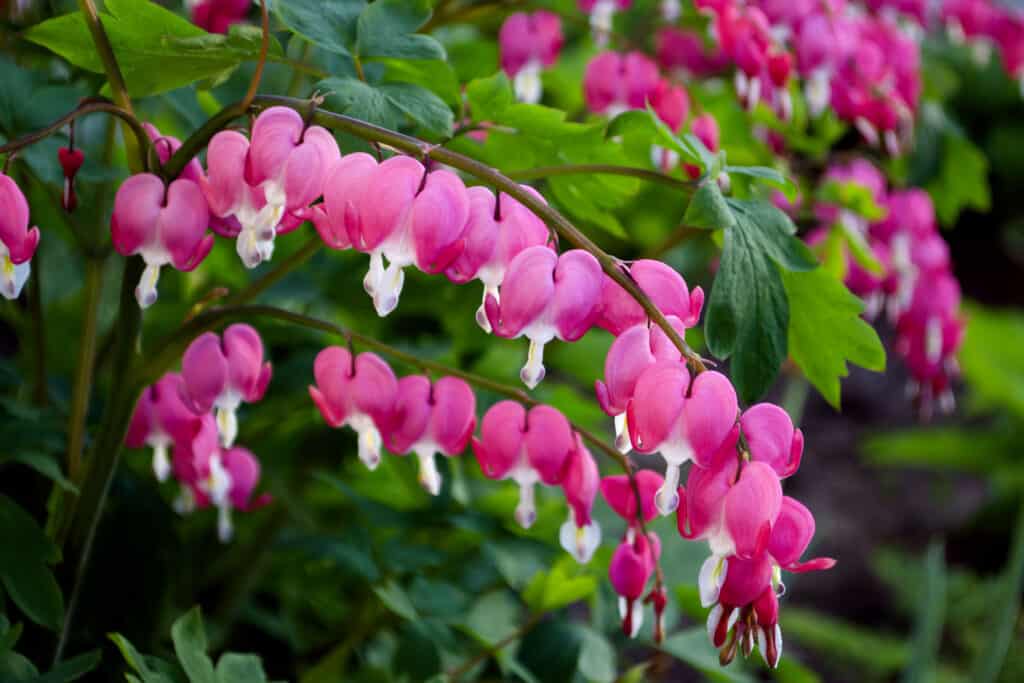
The Bleeding Heart appears as if it’s melting.
©iStock.com/Oksana Akhtanina
2. Bleeding Heart (Lamprocapnos spectabilis)
Native to Siberia, the Koreas, and Northern China, this evocatively named flower symbolizes profound emotion and sorrow, courtesy of its unique heart-shaped petals that appear to bleed. In Asia, people often associate it with a broken heart or unrequited love.
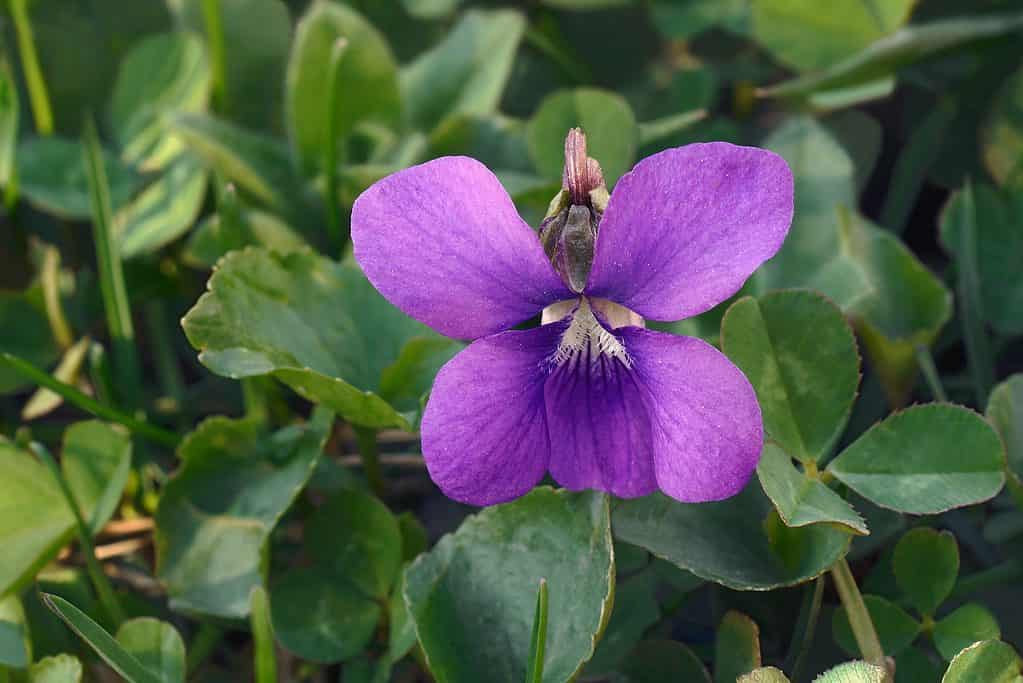
Deeply imbued with myth and meaning, blue violets appear as if they have many stories to tell.
©Nikolay Kurzenko/Shutterstock.com
3. Blue Violets (Viola sororia; Viola odorata)
Native to Europe and Asia, these flowers are emblems of sexuality and linked Aphrodite. Historically, people have associated blue violets with abandonment due to Greek mythology. The nymph Evadne and the god Apollo gave birth to Iamus. Unfortunately, the gods forced Evadne to abandon Iamus at birth. To this day, blue violets often represent the melancholy of lost love.
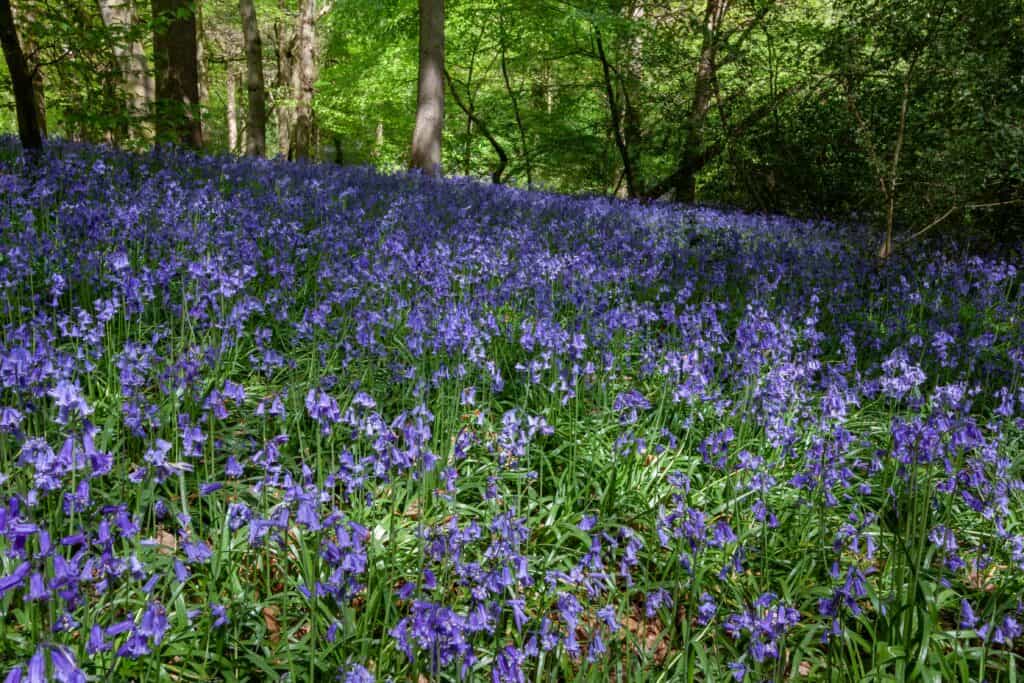
It’s fitting that bluebells thrive in the shade.
©Philip Bird LRPS CPAGB/Shutterstock.com
4. Bluebell (Hyacinthoides non-scripta)
People frequently tie the bluebell to feelings of sorrow and remorse. Folk tales and myths often depict fields of bluebells as dwelling places for spirits and fairies, signifying realms of mourning and loss.

A popular choice for gardeners across the world, these mums have a long history of meaning in both Asia and Europe.
©Mariia Romanyk/Shutterstock.com
5. Chrysanthemum (Chrysanthemum spp.)
In Europe, chrysanthemums are common in funerals and stand for grief and lamentation. People often refer to as “mums,” for short.
In contrast, Asian countries like China and Japan hold the chrysanthemum in high esteem, associating it with longevity, resilience, and beauty.
In Chinese culture, chrysanthemums traditionally symbolize autumn because they bloom in late summer and autumn. They are one of the “Four Gentlemen” of Chinese art, which also includes the plum blossom, the orchid, and bamboo. Each of these represents a season and embodies virtues like integrity, resilience, and beauty.
Partly because of its medicinal uses, people often see the chrysanthemum as a symbol of longevity and vitality. It’s a common ingredient in traditional Chinese medicine, believed to have cooling and anti-inflammatory effects. Folklore claims that consuming chrysanthemum petals could extend one’s life.
In Japan, the chrysanthemum symbolizes rejuvenation and longevity. It is deeply entwined with national identity and is the crest and symbol of the Imperial family. Depending on the region, people celebrate Kiku (the Japanese word for chrysanthemum) Day in September or October.
The chrysanthemum signifies rejuvenation and longevity in Japan. Viewed as a noble flower, it appears in official seals and emblems. The Japanese monarchy goes by the name “The Chrysanthemum Throne.” Official government documents and passports also feature the chrysanthemum crest.
However, unlike in East Asia, places like Singapore, perhaps influenced by Europe, associate the flower with funerals, loss, and sadness.
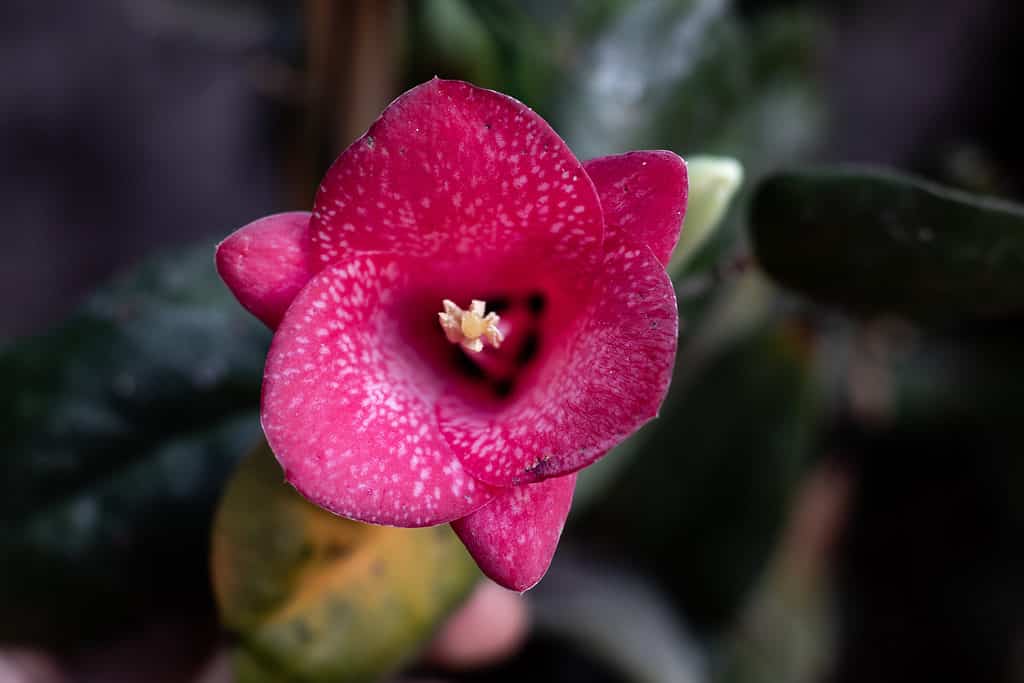
One of the few flowers, if not the only, that plays a central role in Indigenous creation myths.
©Rodrigom Lira Alarcon/Shutterstock.com
6. Copihue (Chilean Bellflower) – (Lapageria rosea)
Chile’s national flower carries the weight of a tragic Mapuche creation myth. It tells the indigenous tale of a doomed love affair between a warrior and a princess, rendering the flower a symbol of unfulfilled love and sorrow.

This flower, known as champa in Asia and frangipani elsewhere, is the national flower of both Laos and Nicaragua.
©AJWalsh/Shutterstock.com
7. Frangipani (Champa) – (Plumeria spp.)
In various Southeast Asian cultures, people often use the frangipani flower in rituals and ceremonies to commemorate the dead. While it holds diverse meanings, including life and fertility, its sacred role in funerals also associates it with sorrow and loss.
Interestingly enough, though frangipani is the national flower of Laos, it actually originates from Central America and found its way to Southeast Asia by way of the French.

This lovely flower bridges the gap between purity and mourning.
©Viacheslav Rubel/Shutterstock.com
8. Lily of the Valley (Convallaria majalis)
Known for representing purity and the promise of happiness, this flower’s symbolism evolved with Christianity to express the purity of Mother Mary’s mourning for Jesus. Thus, people often give Lily of the Valley as a gesture of condolence at funerals.

Many cultures across the world ascribe meanings to marigold, often those associated with death and loss.
©FunFamilyRu/Shutterstock.com
9. Marigold (Tagetes spp.)
In India, people frequently use marigolds in death rituals, mainly for decorating graves and funeral pyres. They also feature in temple offerings and religious ceremonies. Meanwhile, in Mexico, marigolds play a role in Dia de los Muertos celebrations. The marigold is a versatile symbol that is as much about devotion as it is about the agony of loss.
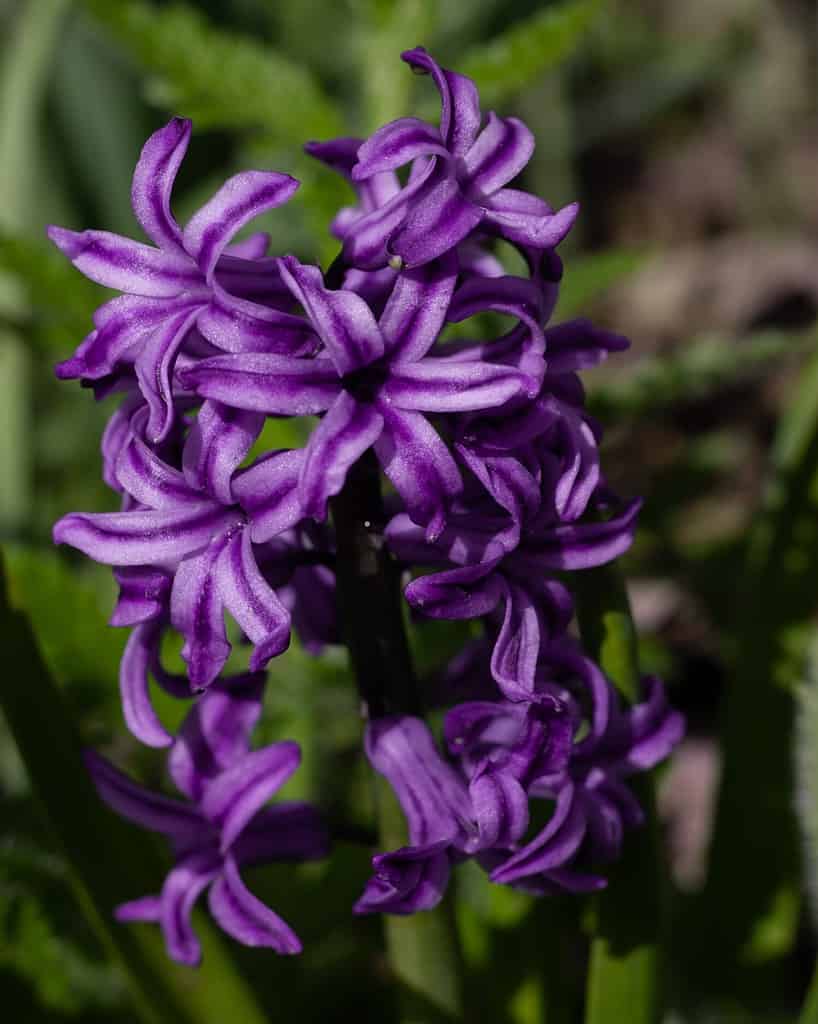
Not unlike Lily of the Valley, the purple hyacinth bridges two concepts, sorrow and forgiveness.
©Evgenia1969/Shutterstock.com
10. Purple Hyacinth (Hyacinthus orientalis)
The purple hyacinth has a dual symbolism of both sorrow and forgiveness. Greek mythology states that the flower sprang from the blood of Hyacinthus, a youth whom both Apollo and Zephyr loved and who died in a tragic accident. The flower is a remembrance of sorrow and grief.

Given their striking blooms from below, it is understandable why the Japanese associate Red Spider Lilies with the afterlife.
©pianoman555/Shutterstock.com
11. Red Spider Lily (Lycoris radiata)
In Japan, people often place this flower near graves, believing it guides souls in the afterlife. This adds layers of sorrow and mourning to its symbolism.
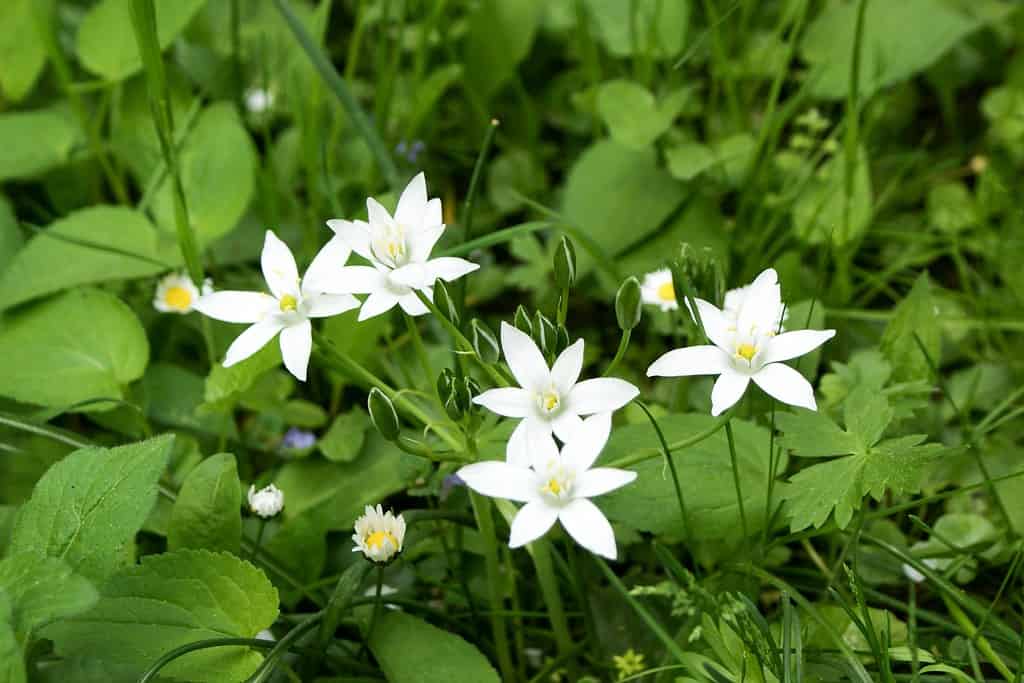
Star of Bethlehem
©Joerg-alois/Shutterstock.com
12. Star of Bethlehem (Ornithogalum umbellatum)
This flower symbolizes purity and spiritual awakening. However, Christians associate the Star of Bethlehem to sorrow, as it often blooms around Easter.
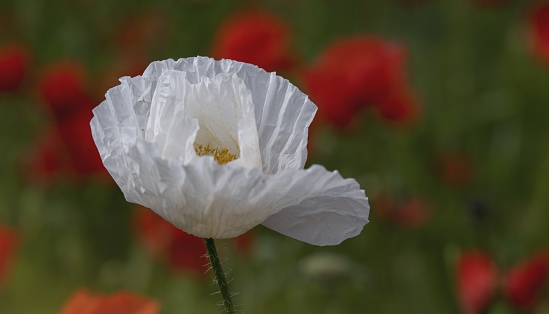
The paper-like petals evoke a sense of fragility in the white poppy.
©Artur Augustyniak/iStock via Getty Images
13. White Poppy (Papaver somniferum var. album)
People often use the white poppy as a symbol of peace to memorialize those who have died in wars. Thus, it’s imbued with a poignant sense of remembrance and sorrow.

With its strong scent, wormwood is distinct from other herb-like flowering plants.
©iStock.com/Larysa Lyundovska
14. Wormwood (Artemisia absinthium)
This flower, emblematic of bitter experiences and calamities, appears in absinthe. Wormwood is toxic in large quantities, it carries a heavy undertone of sorrow and loss. Specifically, people associate it with the sad parting of friends and often use it to represent the bitterness of such a break.

It’s hard to imagine any plant growing in Antarctica, but there are two flowering plants that do just that.
©euphro / CC BY-SA 2.0 – License
Maybe Even Two Can Be the Loneliest Number? 15 & 16
Antarctic Hair Grass (Deschampsia antartica) and Antarctic Pearlwort (Colobanthus quitensis)
While there are no traditional symbolic investments in these flowers, they are the only two flowers in the entire expanse of the Antarctic continent. Their struggle to exist in such an extreme environment could be metaphorically linked to feelings of isolation or despair.
What Do We Mean by Sadness, Anyway?
The experience of sadness is a multifaceted human emotion, shaped by psychological, biological, cultural, and social contexts. While often considered a negative feeling, emerging research suggests that sadness serves adaptive functions that can positively influence various aspects of our lives. This comprehensive examination aims to untangle the complexities surrounding sadness, looking through the lenses of various disciplines and contexts.
Psychological Insights
Paul Ekman identified sadness as one of the six basic emotions, along with happiness, anger, fear, surprise, and disgust. Although considered a healthy emotional response when proportional to its trigger, persistent or disproportionate sadness can evolve into mood disorders like depression or anxiety.
The Biology of Sadness
From a biological standpoint, sadness is linked to neural activity in the amygdala and the prefrontal cortex. Neurotransmitters like serotonin and dopamine also modulate this emotion. Some evolutionary psychologists propose that sadness serves a functional role, signaling the need for social support or behavioral adjustment.
Cultural Interpretations
Cultural norms shape how sadness is expressed and understood. For example, many Asian cultures value emotional restraint, leading to more subdued expressions of sadness. Conversely, Latin American cultures view emotional expressiveness, even sadness, as a testament to one’s authenticity and strength.
The Social Dimension
In the social realm, sadness influences and is influenced by interpersonal relationships. It can elicit empathy and offer a sense of collective identity, especially in times of communal loss or tragedy. However, poorly managed sadness can also become isolating.
Artistic and Literary Expressions
Artistic mediums like music and literature offer a nuanced exploration of sadness, serving as a cathartic outlet for both creators and consumers. Works ranging from blues music to cross-cultural poetry capture the emotional intricacies of sadness.
Environmental Factors
External surroundings, such as weather conditions or locations tied to tragedy, can evoke or intensify sadness. Seasonal Affective Disorder (SAD) exemplifies how environmental changes can lead to depressive states.

©Nico.Stock/Shutterstock.com
Cross-Domain Intersections
Sadness intersects intriguingly with broader societal issues, like “eco-anxiety” brought on by climate change or emotional ramifications of social media usage, particularly among young people. Or one can take bring all the knots together in what the Germans call Weltschmerz, or “pain of the world.”
Philosophical Considerations
Existential philosophers like Søren Kierkegaard and Jean-Paul Sartre have probed the role of sadness in the human condition, examining themes like mortality and existential isolation. They advocate for an authentic engagement with this emotion as a form of self-discovery.
Adaptive Functions of Sadness
Recent studies, supported by fMRI imaging, highlight surprising benefits of mild, temporary sadness—improvements in attention, memory recall, and reduced biases. These adaptive functions suggest that sadness isn’t purely detrimental but can serve a constructive role.
Varied Physiological Responses
Research also suggests the existence of sadness subtypes, each associated with unique physiological responses. For instance, sadness due to loss yields different physiological reactions compared to sadness resulting from failure.
Real-world Implications and the COVID-19 Lens
Studies during the COVID-19 pandemic have revealed both the adaptive and maladaptive functions of sadness, from enhancing fairness to causing psychosocial distress. The pandemic underscores the need to manage sadness effectively to prevent it from escalating into severe emotional turmoil.
Neurobiological Implications
Research into the neurobiology of sadness has led to the identification of reduced cortical control over ancient brain systems. These findings have critical implications for mental health treatment, advocating for a targeted, neurobiology-based approach.
Conclusion
We ascribe sadness to these flowers because they intersect with our rituals, influencing everything from the way we grieve to the art we create. They give color and shape to our internal struggles. However, as climate change impacts plant species’ biodiversity, it may threaten the availability or even existence of some of these flowers. Just like how the loss of animal species degrades the richness of Earth’s biodiversity, the loss of flower species can indirectly hollow out our deeply ingrained modes of cultural expression. Therefore, the topic of floral symbolism evolves into not just a cultural discussion but also an environmental one, illustrating the intricate interconnection between nature and human emotion.
Summary of 16 Flowers That Mean Sadness
| Number | Flower | Scientific Name |
|---|---|---|
| 1 | Black Roses | Rosa spp. |
| 2 | Bleeding Heart | Lamprocapnos spectabilis |
| 3 | Blue Violets | Viola sororia; Viola odorata |
| 4 | Bluebell | Hyacinthoides non-scripta |
| 5 | Chrysanthemum | Chrysanthemum spp. |
| 6 | Copihue (Chilean Bellflower) | Lapageria rosea |
| 7 | Frangipani (Champa) | Plumeria spp. |
| 8 | Lily of the Valley | Convallaria majalis |
| 9 | Marigold | Tagetes spp. |
| 10 | Purple Hyacinth | Hyacinthus orientalis |
| 11 | Red Spider Lily | Lycoris radiata |
| 12 | Star of Bethlehem | Ornithogalum umbellatum |
| 13 | White Poppy | Papaver somniferum var. album |
| 14 | Wormwood | Artemisia absinthium |
| 15 | Antarctic Hair Grass | Deschampsia antartica |
| 16 | Antarctic Pearlwort | Colobanthus quitensis |
The photo featured at the top of this post is © TommyBrison/Shutterstock.com
Thank you for reading! Have some feedback for us? Contact the AZ Animals editorial team.







